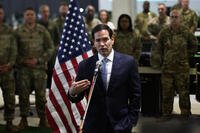NELLIS AIR FORCE BASE, Nev. -- The Air Force doesn't have enough aircraft or range space for pilots to train for combat against a sophisticated enemy, so it's looking to link real and simulated environments at a new training center.
Pilots taking part in Red Flag air-to-air combat training exercises could soon face new virtual threats on top of those they're seeing in real life. That's one of the possibilities leaders see out of a new $38 million Virtual Test and Training Center here.
Maj. Gen. Chuck Corcoran, commander of the Air Force Warfare Center, said the center will prep pilots who could be called into a great power competition. Officials gave Military.com a tour of the new 60,000-square-foot center, which had its ribbon-cutting ceremony last week.
"There's no live training venue for the joint force -- and certainly for the Air Force -- that's big enough or that has the threat density that can replicate what China or Russia can do," Corcoran said. "So the live training venues ... and testing venues we have, we have to do what we can on those, collect data, and then feed that into the virtual world and scale it to the size and scope we need."
Read Next: Inspectors Said Her Toxic Leadership Was 'Worst Seen in 20 Years.' She Just Became a 1-Star
The Air Force plans to install F-15E Strike Eagle simulators in the new building. The Virtual Test and Training Center's campus will also include F-35 Joint Strike Fighter, F-22 Raptor and F-16 Fighting Falcon simulator buildings located here at Nellis.
"Any conflict in the world could be simulated here," said Lt. Col. Chris "Slam" Duncan, an F-35 operational test pilot and commander of Detachment 1, 29th Training Systems Squadron.
That could include virtually adding other services' or allies' aircraft into a Red Flag mission, so they're all flying in the same airspace simultaneously. Eventually, Duncan said, participants from around the world could join in the training.
The Air Force wants the new virtual center linked with the Joint Simulation Environment, a government-owned modeling environment where fifth generation-plus aircraft and systems can be tested.
"This is a generational leap in the way we train," Duncan said. "This allows us to validate tactics, techniques and procedures we otherwise could not do [on this scale]."
It's going to cost the Air Force to get the networking and processing tools and simulators that allow it to carry out the type of ambitious testing it wants to do here. But Duncan said there's no other way for the services to train for this level of fighting, and the initial investment is far less than what it would cost to even try doing so in real life.
"The bang for the buck far surpasses what we can do in live flying," he said. "Just like anything, it's a large initial investment to get to where we want, but ... however many thousands of dollars those airplanes cost to fly per hour, you wouldn't have that here."
-- Gina Harkins can be reached at gina.harkins@military.com. Follow her on Twitter @ginaaharkins.
Related: US Pilots' Close Calls with Russian Aircraft Are Likely to Continue, Experts Say












